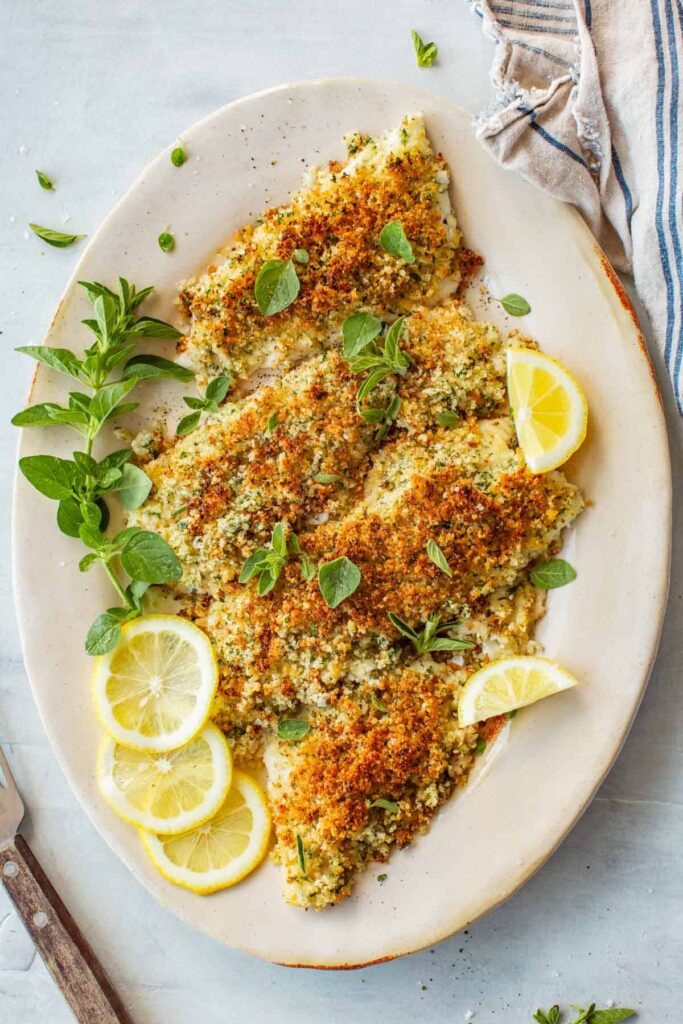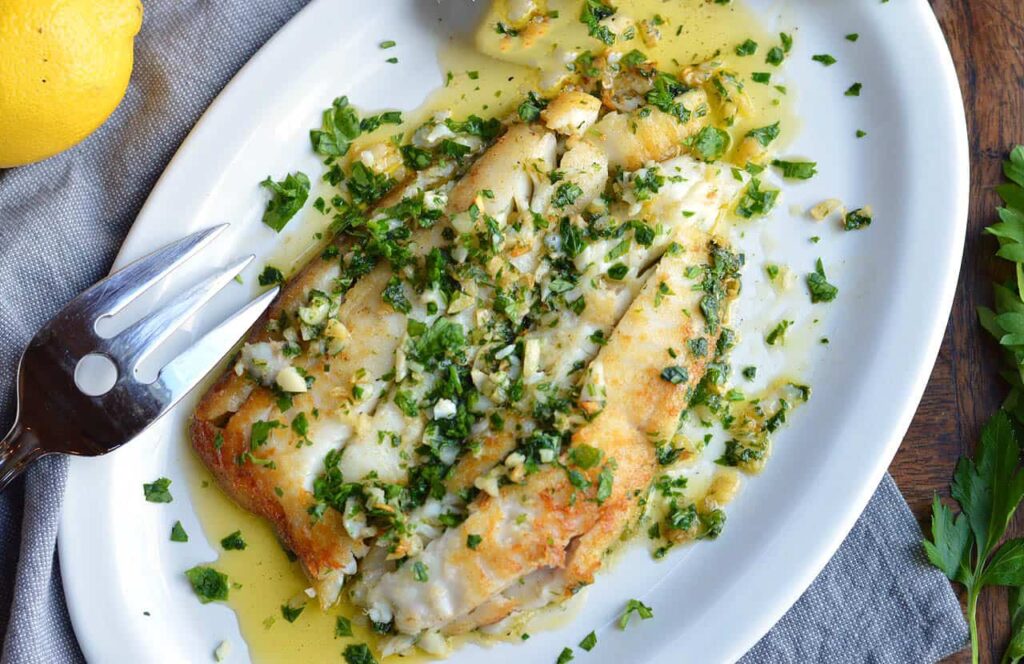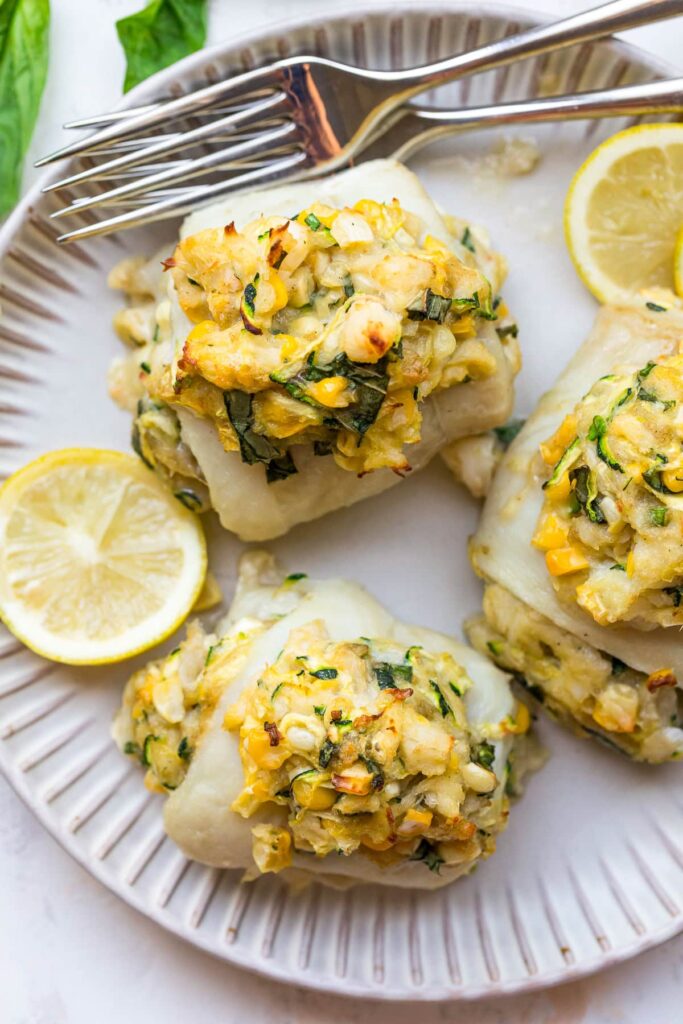Flounder, with its delicate, flaky texture and mild flavor, is a versatile fish that shines in simple yet elegant dishes. Among the many ways to prepare flounder, lemon garlic flounder stands out as a classic, crowd-pleasing option. The bright, zesty notes of lemon paired with the aromatic warmth of garlic create a perfect harmony that elevates the fish without overpowering its natural qualities. In this article, we’ll explore why lemon garlic flounder is a go-to seafood dinner, share three simple recipes, provide cooking tips, and suggest pairings to make your meal unforgettable. Whether you’re a seasoned home cook or a beginner, these recipes from https://tastetrove.net/ will help you create a restaurant-quality dish at home.
Why Choose Flounder for Your Seafood Dinner?
Flounder is a flatfish found in coastal waters, known for its tender, white flesh and subtle flavor. It’s a fantastic choice for quick weeknight dinners because it cooks in under 15 minutes and pairs well with a variety of seasonings. According to the National Oceanic and Atmospheric Administration (NOAA), flounder is a sustainable seafood option, making it an eco-friendly choice for environmentally conscious cooks. Its low fat content and high protein make it a healthy option, with approximately 90 calories and 19 grams of protein per 3-ounce serving, as noted by the USDA.
The lemon garlic combination is particularly well-suited to flounder because it enhances the fish’s mild flavor without overwhelming it. Lemon adds brightness and a touch of acidity, while garlic provides depth and savoriness. Together, they create a balanced dish that’s both refreshing and comforting. Plus, these ingredients are pantry staples, making lemon garlic flounder an accessible recipe for any home cook.
Recipe 1: Classic Lemon Garlic Pan-Seared Flounder
This recipe is a quick and easy way to prepare flounder, perfect for a weeknight dinner. The pan-searing method creates a golden crust while keeping the fish tender and juicy.
Ingredients (Serves 4)
- 4 flounder fillets (4–6 oz each)
- 2 tbsp olive oil
- 3 cloves garlic, minced
- Juice and zest of 1 lemon
- 2 tbsp unsalted butter
- 1 tbsp fresh parsley, chopped
- Salt and black pepper to taste
- Lemon wedges for serving
Instructions
- Prepare the Fillets: Pat the flounder fillets dry with paper towels. Season both sides with salt and black pepper.
- Heat the Pan: In a large skillet, heat olive oil over medium-high heat until shimmering.
- Sear the Flounder: Add the fillets to the skillet, cooking for 2–3 minutes per side until golden brown and cooked through (internal temperature should reach 145°F, per FDA guidelines). Transfer to a plate and cover to keep warm.
- Make the Lemon Garlic Sauce: In the same skillet, reduce heat to medium. Add butter and minced garlic, cooking for 1 minute until fragrant. Stir in lemon juice and zest, scraping up any browned bits from the pan.
- Combine and Serve: Spoon the sauce over the flounder fillets. Garnish with parsley and serve with lemon wedges.
Cooking Time
- Prep: 5 minutes
- Cook: 10 minutes
- Total: 15 minutes
Tips
- Use fresh garlic for the best flavor, as pre-minced garlic can taste bitter.
- Don’t overcook the flounder; it should flake easily with a fork but remain moist.
- For extra flavor, try adding a pinch of red pepper flakes to the sauce.
This dish pairs beautifully with TasteTrove’s Garlic Mashed Potatoes for a comforting meal.

Recipe 2: Baked Lemon Garlic Flounder with Herbs
Baking flounder is a hands-off method that’s perfect for busy evenings. This recipe infuses the fish with lemon, garlic, and fresh herbs for a fragrant, flavorful result.
Ingredients (Serves 4)
- 4 flounder fillets (4–6 oz each)
- 2 tbsp olive oil
- 3 cloves garlic, thinly sliced
- Juice of 1 lemon
- 1 tsp lemon zest
- 1 tbsp fresh thyme, chopped
- 1 tbsp fresh dill, chopped
- Salt and black pepper to taste
- 1/4 cup dry white wine (optional)
- Lemon slices for garnish
Instructions
- Preheat the Oven: Preheat your oven to 400°F (200°C).
- Prepare the Fillets: Place flounder fillets in a greased baking dish. Season with salt and pepper.
- Add Flavorings: Drizzle olive oil and lemon juice over the fillets. Sprinkle with garlic slices, lemon zest, thyme, and dill. If using, pour white wine around the fillets.
- Bake: Bake for 10–12 minutes, or until the fish flakes easily and reaches an internal temperature of 145°F.
- Serve: Garnish with lemon slices and serve hot.
Cooking Time
- Prep: 10 minutes
- Cook: 12 minutes
- Total: 22 minutes
Tips
- The white wine adds a subtle depth but can be omitted for a non-alcoholic version.
- Use a shallow baking dish to ensure even cooking.
- Check out TasteTrove’s Guide to Fresh Herbs for tips on selecting the best herbs.
This recipe pairs well with a crisp green salad or roasted asparagus, as suggested in TasteTrove’s Spring Vegetable Sides.
Recipe 3: Lemon Garlic Grilled Flounder in Foil Packets
Grilling flounder in foil packets locks in moisture and flavor, making it a foolproof method for outdoor cooking or a summer barbecue.
Ingredients (Serves 4)
- 4 flounder fillets (4–6 oz each)
- 2 tbsp olive oil
- 4 cloves garlic, minced
- Juice and zest of 1 lemon
- 1 tsp smoked paprika
- 1 tbsp fresh basil, chopped
- Salt and black pepper to taste
- Lemon slices for grilling
- Aluminum foil
Instructions
- Preheat the Grill: Heat your grill to medium-high (about 400°F).
- Prepare Foil Packets: Cut four large pieces of aluminum foil. Place a flounder fillet in the center of each piece.
- Season the Fillets: Drizzle each fillet with olive oil and lemon juice. Sprinkle with garlic, lemon zest, smoked paprika, basil, salt, and pepper. Top with a lemon slice.
- Seal and Grill: Fold the foil over the fillets to create sealed packets. Place on the grill and cook for 8–10 minutes, or until the fish is opaque and flakes easily.
- Serve: Carefully open the packets to avoid steam. Serve directly from the foil or transfer to plates.
Cooking Time
- Prep: 10 minutes
- Cook: 10 minutes
- Total: 20 minutes
Tips
- Ensure the foil packets are tightly sealed to trap steam and keep the fish moist.
- For a smoky flavor, add a pinch of smoked paprika or use a cedar plank, as described in TasteTrove’s Grilling Tips.
- If you don’t have a grill, bake the packets in a 400°F oven for the same amount of time.
This dish is excellent with TasteTrove’s Grilled Vegetable Medley for a complete outdoor meal.
Cooking Tips for Perfect Lemon Garlic Flounder
To ensure your lemon garlic flounder is a success, keep these tips in mind:
- Choose Fresh Flounder: Look for fillets with a mild, fresh scent and firm texture. Frozen flounder can work well too; just thaw it in the refrigerator overnight. The Monterey Bay Aquarium Seafood Watch recommends choosing sustainably sourced flounder.
- Don’t Overcook: Flounder cooks quickly, so check for doneness early to avoid a dry texture. A meat thermometer is handy to confirm the internal temperature.
- Balance Flavors: Lemon and garlic should complement, not dominate, the fish. Taste the sauce before serving and adjust seasoning as needed.
- Experiment with Citrus: Try swapping lemon for lime or orange for a different twist, as explored in TasteTrove’s Citrus Cooking Guide.
Pairing Suggestions
Lemon garlic flounder pairs beautifully with a variety of sides and beverages. Here are some ideas to complete your meal:
- Sides:
- Rice Pilaf: A light, fluffy rice pilaf with herbs complements the fish’s delicate flavor. Try TasteTrove’s Herbed Rice Pilaf.
- Roasted Vegetables: Seasonal vegetables like zucchini or carrots add color and nutrition. See TasteTrove’s Roasted Veggie Recipes.
- Quinoa Salad: A lemony quinoa salad adds protein and texture. Check out TasteTrove’s Quinoa Salad Guide.
- Beverages:
- White Wine: A crisp Sauvignon Blanc or Pinot Grigio enhances the lemony notes. The Wine Enthusiast suggests these varietals for seafood.
- Non-Alcoholic: A sparkling lemon-infused water or iced herbal tea pairs well for a refreshing option.
- Desserts: Finish with a light dessert like lemon sorbet or fruit tart, as featured in TasteTrove’s Summer Desserts.
Nutritional Benefits of Flounder
Flounder is not only delicious but also packed with health benefits. It’s a lean source of protein, low in saturated fat, and rich in omega-3 fatty acids, which support heart health, according to the American Heart Association. It’s also a good source of vitamins B12 and D, which are essential for energy and bone health. The lemon and garlic in these recipes add antioxidants and anti-inflammatory properties, making this dish as nutritious as it is flavorful.
Variations and Substitutions
If you want to switch things up, here are some variations:
- Spicy Lemon Garlic Flounder: Add a pinch of cayenne pepper or chili flakes to the sauce for a kick.
- Creamy Lemon Garlic Flounder: Stir in 1/4 cup of heavy cream to the pan-seared recipe’s sauce for a richer texture.
- Gluten-Free: All three recipes are naturally gluten-free, but double-check any packaged ingredients like spices.
- Alternative Fish: If flounder isn’t available, try cod, tilapia, or sole, which have similar textures and mild flavors.
Why Lemon Garlic Flounder is Perfect for Any Occasion
Whether you’re hosting a dinner party or preparing a quick family meal, lemon garlic flounder fits the bill. Its simplicity makes it accessible for beginners, while its elegant flavors impress even the most discerning guests. The recipes above are versatile enough to adapt to your preferences, whether you prefer the crispy texture of pan-searing, the ease of baking, or the smoky charm of grilling.
For more seafood inspiration, explore TasteTrove’s Seafood Collection for recipes like Grilled Salmon with Herb Sauce or Shrimp Scampi. If you’re new to cooking fish, our Beginner’s Guide to Seafood offers tips to build your confidence.
Conclusion
Lemon garlic flounder is a timeless seafood dish that combines simplicity with sophistication. With just a handful of ingredients and minimal prep time, you can create a meal that’s both healthy and delicious. Whether you choose the pan-seared, baked, or grilled version, these recipes from TasteTrove will make your next seafood dinner a hit. Try them out, experiment with your own twists, and share your creations with us on TasteTrove’s Community Page. Happy cooking!
FAQs About Lemon Garlic Flounder
Below are some frequently asked questions about preparing and enjoying lemon garlic flounder, designed to help you master this delicious seafood dish for your next meal on TasteTrove.
1. What does flounder taste like?
Flounder has a mild, slightly sweet flavor with a delicate, flaky texture. Its subtle taste makes it an excellent canvas for bold flavors like lemon and garlic, which enhance without overpowering the fish.
2. How do I know if flounder is fresh?
Fresh flounder should have a mild, ocean-like scent and firm, translucent flesh. Avoid fish with a strong “fishy” odor or slimy texture. If buying frozen, ensure the fillets are free of freezer burn. Check TasteTrove’s Seafood Guide for more tips on selecting fresh fish.
3. Can I use frozen flounder for these recipes?
Yes! Frozen flounder works well. Thaw it overnight in the refrigerator or place sealed fillets in cold water for 30–60 minutes before cooking. Pat dry to ensure proper searing or baking.
4. How do I prevent flounder from becoming dry?
Flounder cooks quickly, so avoid overcooking. Aim for an internal temperature of 145°F, as recommended by the FDA. Using a sauce, like the lemon garlic butter in the pan-seared recipe, or cooking in foil packets helps retain moisture.
5. Can I substitute other fish for flounder?
Yes, fish like cod, tilapia, sole, or haddock are great substitutes due to their similar mild flavor and flaky texture. Adjust cooking times slightly, as thicker fillets may take a minute or two longer.
6. Is lemon garlic flounder healthy?
Absolutely! Flounder is low in calories (about 90 per 3 oz serving) and high in protein and omega-3 fatty acids, which support heart health, per the American Heart Association. Lemon and garlic add antioxidants without extra calories.
7. Can I make lemon garlic flounder gluten-free?
All three lemon garlic flounder recipes (pan-seared, baked, and grilled) are naturally gluten-free. Just ensure any additional ingredients, like spices or side dishes, are certified gluten-free. Explore TasteTrove’s Gluten-Free Recipes for more options.
8. What sides pair well with lemon garlic flounder?
Light sides like rice pilaf, roasted vegetables, or a green salad complement the dish. Try TasteTrove’s Herbed Rice Pilaf or Roasted Veggie Recipes for inspiration.

9. Can I prepare lemon garlic flounder ahead of time?
You can prep the ingredients (e.g., chop garlic, zest lemon) a few hours in advance. For the baked or grilled recipes, assemble the dish up to the cooking step and refrigerate for up to 4 hours. Cook just before serving to ensure the best texture.
10. How can I add more flavor to lemon garlic flounder?
Experiment with additional herbs like rosemary or oregano, a pinch of red pepper flakes for heat, or a splash of white wine for depth. Check out TasteTrove’s Citrus Cooking Guide for creative flavor ideas.
For more seafood recipes and cooking tips, visit TasteTrove’s Seafood Collection.
Additional FAQs About Lemon Garlic Flounder
Here are more frequently asked questions to help you perfect your lemon garlic flounder dishes and enhance your cooking experience with TasteTrove. These address common concerns and provide further insights for creating a delicious seafood dinner.
1. Can I use bottled lemon juice instead of fresh for lemon garlic flounder?
While fresh lemon juice is preferred for its bright, vibrant flavor, bottled lemon juice can be used in a pinch. Use about 2 tablespoons of bottled juice per fresh lemon. However, fresh lemon zest adds a unique aroma that bottled juice can’t replicate, so consider adding a touch of citrus extract if possible.
2. How do I store leftover lemon garlic flounder?
Store cooked flounder in an airtight container in the refrigerator for up to 2 days, per USDA guidelines. Reheat gently in a microwave or oven at low heat (about 250°F) to avoid drying out the fish. Avoid freezing cooked flounder, as it can become mushy when thawed.
3. Can I make lemon garlic flounder dairy-free?
Yes! For the pan-seared recipe, substitute butter with additional olive oil or a dairy-free alternative like vegan butter. The baked and grilled recipes are naturally dairy-free. Check TasteTrove’s Dairy-Free Recipes for more dairy-free cooking ideas.
4. What’s the best way to clean my pan after cooking flounder?
To clean a skillet after pan-searing flounder, let it cool slightly, then scrape off any stuck bits with a spatula. Soak in warm, soapy water for 10 minutes, then scrub gently. For stubborn residue, simmer a mixture of water and vinegar in the pan, as suggested in TasteTrove’s Kitchen Cleaning Tips.
5. Can I cook lemon garlic flounder in an air fryer?
Yes! Preheat your air fryer to 400°F. Season the flounder as in the baked recipe, place fillets in a single layer in the basket, and cook for 6–8 minutes, flipping halfway, until the fish reaches 145°F. Spray lightly with olive oil for a crispier texture.
6. Is lemon garlic flounder kid-friendly?
Flounder’s mild flavor makes it appealing to kids, and the lemon garlic sauce is gentle enough for young palates. To make it even more kid-friendly, reduce the garlic to 1–2 cloves and serve with familiar sides like mashed potatoes. Explore TasteTrove’s Kid-Friendly Meals for more family-oriented recipes.
7. How do I know when flounder is fully cooked?
Flounder is done when it flakes easily with a fork and appears opaque. For precision, use a meat thermometer to check for an internal temperature of 145°F, as recommended by the FDA. Overcooking can make it dry, so check early.
8. Can I use dried herbs instead of fresh in these recipes?
Yes, dried herbs like thyme, dill, or basil can be used. Use 1/3 the amount of dried herbs compared to fresh (e.g., 1 tsp dried for 1 tbsp fresh), as they’re more concentrated. For tips on herb substitutions, see TasteTrove’s Guide to Fresh Herbs.

9. What’s the best way to source sustainable flounder?
Look for flounder certified by the Marine Stewardship Council (MSC) or rated “Best Choice” by the Monterey Bay Aquarium Seafood Watch. Buying from local fish markets or reputable grocers ensures quality and sustainability.
10. Can I make lemon garlic flounder low-sodium?
To reduce sodium, use unsalted butter or olive oil, skip added salt, and rely on lemon, garlic, and herbs for flavor. Low-sodium vegetable broth can replace white wine in the baked recipe. Check TasteTrove’s Low-Sodium Recipes for more heart-healthy ideas.
For additional seafood inspiration, visit TasteTrove’s Seafood Collection or try related recipes like Lemon Herb Cod.
